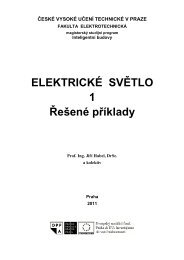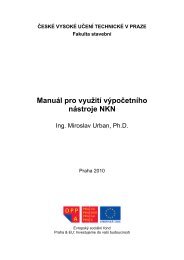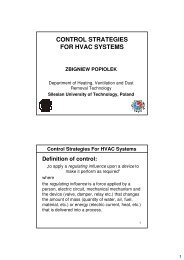Buses, Protocols and Systems for Home and Building Automation
Buses, Protocols and Systems for Home and Building Automation
Buses, Protocols and Systems for Home and Building Automation
You also want an ePaper? Increase the reach of your titles
YUMPU automatically turns print PDFs into web optimized ePapers that Google loves.
Evropský sociální fond. Praha & EU: Investujeme do vaší budoucnosti.<br />
Advantages<br />
- Easy modification – no need of rewiring in case of a change<br />
- Energy savings – 30-60 % through dimming lights in response to actual brightness of<br />
natural light <strong>and</strong> switching by occupancy sensors.<br />
- More com<strong>for</strong>table lighting (scenes, individual control…)<br />
- Automatic identification of failed lamps <strong>and</strong> ballasts<br />
- Robustness, an interference free operation<br />
Disadvantages<br />
From the point of view of today’s state-of-the-art, DALI is a little bit “archaic” system, which<br />
should be upgraded (new specification 3.0 should come in near future). DALI cannot be used<br />
<strong>for</strong> controlling fast changes of brightness because of its very slow communication speed<br />
1200 b/s. Another disadvantage is a high price of devices, which are equipped with DALI.<br />
A lot of DALI master units still support only a single-master system. Maximal length of the<br />
line is 300 meters <strong>and</strong> only 64 devices can be connected. Also adding more than one sensor<br />
or switch directly into the DALI bus is not easy, because they have to support the multimaster<br />
structure. So an easier way how to solve this problem is to keep the sensors separate<br />
from DALI line <strong>and</strong> send comm<strong>and</strong>s through a central controller (Fig. 3.2.1.5). Moreover, the<br />
market offer of DALI sensors is not very wide.<br />
Interconnections<br />
There exist a gateway to almost every important building <strong>and</strong> home automation system, bus<br />
or protocol: Modbus, DMX512, KNX, BacNet (Loytec), LON or Xcom<strong>for</strong>t/Nikobus. Another<br />
possible option of interconnection is a modular PLC used as an Ethernet gateway <strong>for</strong> DALI or<br />
to connect DALI with EnOcean <strong>and</strong> other protocols.<br />
Future (autumn 2009)<br />
Because DALI is today “a little bit archaic”, but relatively often used system <strong>for</strong> controlling<br />
lights, there should come some new specification of the DALI bus soon, with new<br />
improvements. Besides a new specification, the WAGO Company is preparing (release in 2<br />
years) a new master PLC card, which will support the multi-master DALI.<br />
Further reading:<br />
(21) (22) (23) (24)<br />
3.2.2. DMX512<br />
DMX512 is a simple serial st<strong>and</strong>ard protocol designed especially <strong>for</strong> controlling light sources<br />
(dimmers <strong>and</strong> other light effects in theaters, discotheques…). DMX512 was developed in the<br />
year 1986 by the institute USITT (United States Institute <strong>for</strong> Theatre Technology) <strong>and</strong><br />
updated in the year 1990. The purpose of the developing DMX512 was the same as in the<br />
case of DALI – to replace old-fashioned analog 1-10 V dimming, which has problems with<br />
interference <strong>and</strong> every device has to have its own wires connected to a controller (a star<br />
topology).<br />
Ondřej Nývlt - <strong>Buses</strong>, <strong>Protocols</strong> <strong>and</strong> <strong>Systems</strong> <strong>for</strong> <strong>Home</strong> <strong>and</strong> <strong>Building</strong> <strong>Automation</strong> 23

















